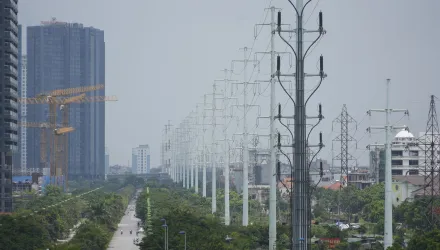
Note
This note was submitted to the Ministry of Power, Government of India, in November 2018
Introduction
As the electricity sector undergoes a transformation in India, new challenges and opportunities are coming to the fore. It is imperative that the institutional framework, i.e., laws, rules, and policies, essential for its efficient operation are updated and redesigned. In that regard, the Electricity (Amendment) Act 2018 is a welcome and timely step.
In this document, concerns are flagged about the process of tariff determination outlined in Sections 61, 62, and 63, of the Electricity Act 2003, where the role of the government and the regulatory commissions are laid out. These sections were chosen specifically because they bear sharp relevance to two ideals enshrined in the preamble of the principal Act: promoting competition and protecting the interest of consumers.
Overreaching Powers of Regulation Severely affect Competition
Both the Electricity Act 2003, to be referred to henceforth as the principal Act, and the Electricity (Amendment) Act 2018, mention "promoting competition" as a goal in their preamble. This goal, was one of the primary reasons the Electricity Act 2003 was passed: to deregulate the sector and ensure efficient delivery of the essential public service of electricity at affordable prices to final consumers, through the application of well-developed and empirically proven economic principles (Haldea 2001).
The international standard for efficient operation of the power sector promotes competition for those of its segments that are not natural monopolies; segments such as generation and retail should be subjected to competition, while the natural monopoly segments of the sector should be regulated by an independent entity (Joskow 2004). These principles have been applied to successfully reduce costs in electricity sectors all over the world (Neuhoff and Newbery 2005). Gajendra Haldea, one of the authors of the Electricity Act 2003, writes (Haldea 2001):
"Since generation typically constitutes over 75 per cent of the consumer tariff, competition among Gencos selling to multiple buyers would bring about significant price and efficiency gains, whereas overlooking this fundamental economic principle would be tantamount to ignoring consumer welfare in the reform design."
In India however, all four segments of the sector are allowed to be subjected to regulation, including the segments that inherently perform better under competition: generation and retail. Of greater concern is the fact that the conditions under which an entity should be subjected to cost-plus regulation via Section 62 or competitive bidding via Section 63 are not defined, inadvertently putting undue powers in the hands of the regulatory commissions. Below I shall explain how regulation of generation has stifled competition in the sector and is leading to significant losses in the sector. I also outline conditions under which cost-plus regulation should be permitted for the generation and retail segments of the electricity sector.
How cost-plus regulation of generation stations has led to public loss
According to a report presented to the Parliament by the Standing Committee on Energy in May 2015 on the Electricity Amendment Bill 2014, the idea behind allowing regulation for the generation sector was that centrally and state owned stations that were built and commissioned prior to the restructuring could be regulated. For new plants however, if the objective were efficiency and consumer welfare, it is entirely arbitrary to let ownership determine whether a certain plant should be subject to competition or regulated. The existing Act 2003 has led to significant losses to public welfare:
- Reports released both by the CERC and Prayas Energy Group demonstrate how lower tariffs are discovered through competitive bidding as opposed to cost-plus regulation (Prayas Energy Group 2011).
- 40 GW of new (either recently commissioned or under construction) capacity, and therefore more efficient power plants, are categorized under "stressed assets" (Standing Committee on Energy, 2018). These plants are almost entirely owned by the private sector. Many of these plants have to be shut down if they are not contracted by distribution companies.
- New and therefore efficient plants with lower marginal costs are being shut down, while older inefficient and largely government-owned plants are enjoying long-term revenue security, even as the country's latent demand for power grows sharply and millions do not have access to reliable electricity.
- Central-government-owned companies such as the NTPC have demonstrably taken advantage of the Act's ambiguity by ensuring all their power plants are regulated under the cost plus model. Their website proudly states "All power plants are under Regulated return model in which Return on equity is assured on cost plus basis subject to achievement of certain operating norms. This results in consistent and strong operational cash flow unlike any other generator in India" (NTPC 2015). Given that NTPC owns almost a fourth of all thermal capacity in India, not subjecting their power plants to competitive bidding leads to huge additional costs to the consumers and reduces the incentive for efficiency.
A possible solution to the problem
Competitive bidding may not be applicable under certain situations; those conditions, however, should be made explicit by the Act, so that the ambiguities that could lead to the loss of public welfare outlined earlier are eliminated. The clarifications should be enshrined in the Act itself so that it is not left to the discretion of the appropriate commission and or the Central Government's Tariff Policies.
Such over-reaching powers of the regulatory commissions have been flagged earlier by several sources — one of them being Gajendra Haldea, the author of the Electricity Act 2003, and recently in 2015 by the Parliamentary Standing Commission on Electricity Act Amendment Bill 2014 (Standing Committee on Energy 2015).
Conditions under which cost-plus regulation should be allowed
Even if one were to allow regulation of generation, the conditions under which regulation can be invoked should be specified, under Section 62. The conditions under which regulation in segments where competition can be enforced are:
- When there are too few competitors, or there is a threat of monopolistic behavior and/or market power. This can be implement by calculating the Herfindalh Index or other standards for meeting competition
- When the grid in question is an island, and the congestion in the network itself limits the choice of the buyer
Role of Central Government vis-à-vis Regulatory Commissions
Under Section 61, sub-section (1) states, "The Appropriate Commission shall, subject to the provisions of this Act, determine the tariff in accordance with the Tariff Policy issued under section 3 of the Act…"
The primary difference between the principal Act, and the Electricity (Amendment) Act 2018 is that regulatory commissions will now be legally bound to defer to the Central Government's Tariff Policy in their tariff determination process. Earlier, the independence of the commissions was enshrined in the Act itself as they were only to be guided by the tariff policy. Now however, regulatory commissions will be bound to comply with the tariff policy that could well favor the government of the day, since the tariff policy can be revised and published by the Central government from time to time, according to Section 3 of the Act.
The 2015 standing committee report sheds light into the thinking behind this measure — that some commissions do not allow distribution companies to recover their costs. However, the solution proposed here, i.e., making regulators answerable to the government, only limits the commission's independence and strengthens the powers of the central government.
The potential consequences of an arrangement where the regulatory commissions are compliant with the central government's policies could be disastrous for the reasons outlined below. The Central government's interests (beyond the efficiency of the electricity sector) could affect tariff determination all over the country. Determination of tariff should be an apolitical activity to ensure that the sector operates on commercial principles. Governments however, are headed by politically elected bodies.
An example of such an instance is when the recent-proposed-amendment to Tariff Policy announced by the Ministry of Power contained a provision which removed the requirement that central and state government owned plants should have to go through competitive bidding in order to secure contracts with potential buyers. Such blatant biases towards public-sector owned plants might serve the interests of public sector undertakings but not necessarily that of the final consumer. Such tariff policy revisions effectively overthrow the idea of competition in the sector, and the new amendment could force regulators all over the country to comply with them!
There is thus a clear conflict-of-interest issue at stake. Regulatory commissions’ independence is paramount, and their powers and/or limitations should be statutorily derived at and should not have to be compliant with central government's policies. The amendment should be changed to "guided by tariff policy."
References
Haldea, Gajendra. 2001. "Whither Electricity Reforms." Economic and Political Weekly, April, 1389–91.
Joskow, Paul L. 2004. "Lessons Learned from Electricity Market Liberalization," 9–42.
Neuhoff, Karsten, and David Newbery. 2005. "Evolution of Electricity Markets: Does Sequencing Matter?" Utilities Policy 13 (2): 163–173. https://doi.org/10.1016/j.jup.2004.12.008.
NTPC. 2015. "NTPC Ltd – A Stellar Performer… Powering India's Growth." Press Releases | NTPC. September 2015. https://www.ntpc.co.in/en/media/press-releases/details/ntpc-ltd-%E2%80%93-stellar-performer%E2%80%A6-powering-india%E2%80%99s-growth.
Prayas Energy Group. 2011. "Transition from MoU to Competitive Bidding : Good Take-off but Turbulence Ahead, Review of Thermal Capacity Addition through Competitive Bidding in India." Pune. http://prayaspune.org/peg/publications/item/140.html.
Standing Committee on Energy. 2015. "Standing Committee on Energy, Fourth Report, Electricity Amendment Bill 2014." http://164.100.47.193/lsscommittee/Energy/16_Energy_4.pdf.
Iychettira, Kaveri ."Comments on India's Draft Electricity (Amendment) Act 2018." Belfer Center for Science and International Affairs, Harvard Kennedy School, April 29, 2019.




